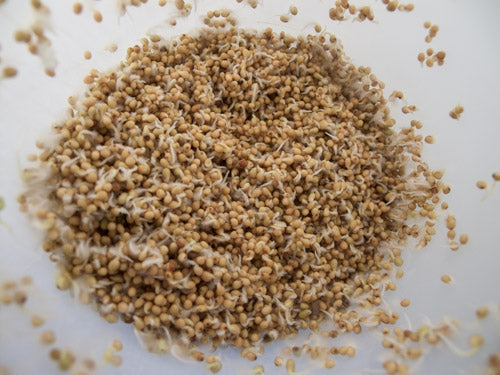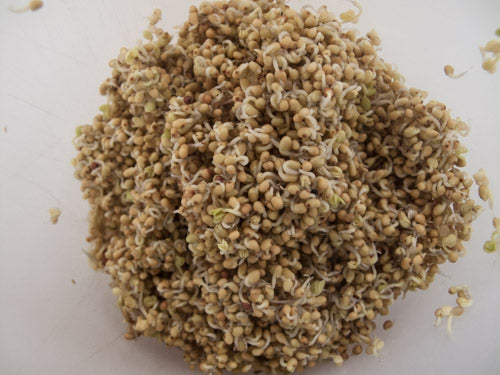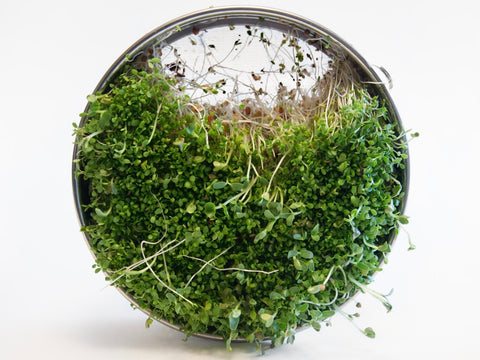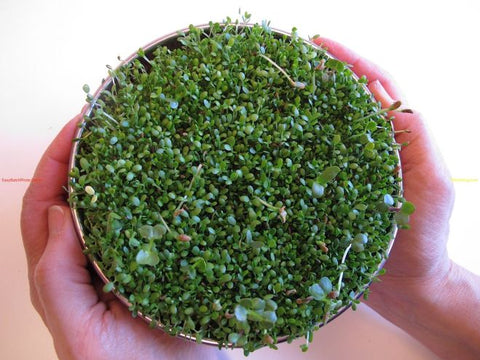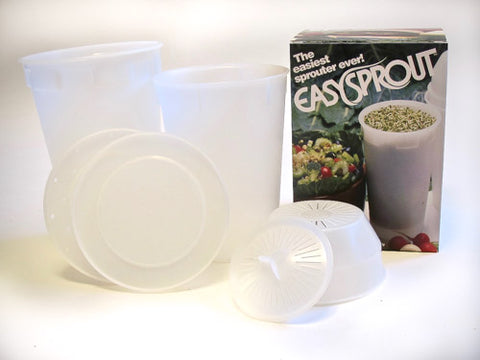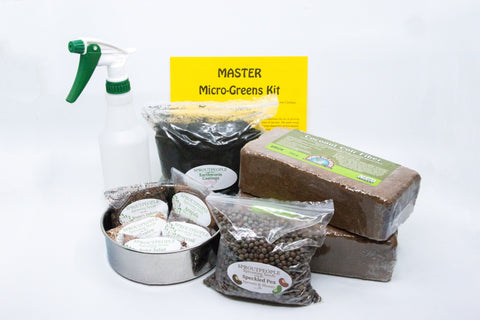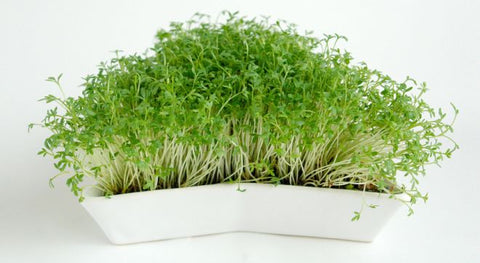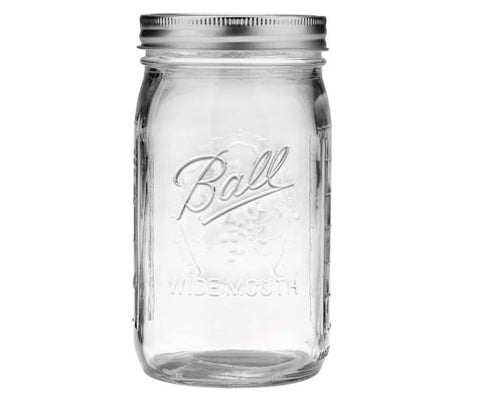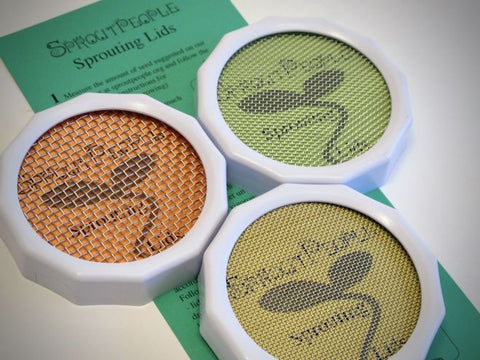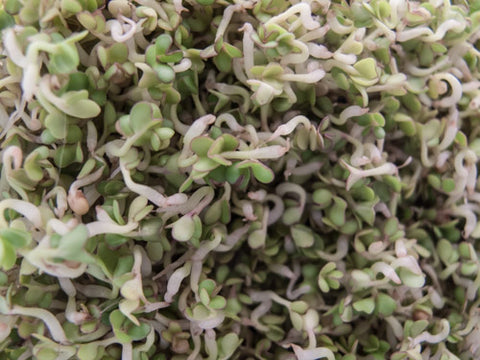
Mustard Sprouts
WE NO LONGER OFFER THIS SEED FOR SPROUTING AS IT IS TOO DIFFICULT FOR MOST PEOPLE TO GROW. IF YOU ARE DETERMINED TO TRY IT YOU CAN ORDER THE SEEDS (from our Mustard Greens page) AND FOLLOW THE INSTRUCTIONS ON THIS PAGE.
The spiciest Brassica of all, our Mustard is called Oriental Mustard. It tastes like horseradish to us!
Note: This is the same seed we sell for Mustard Micro-Greens.
Vitamins A, B, C, E and K
Calcium, Iron, Magnesium, Phosphorus, Potassium, Zinc
Carotene, Chlorophyll, Amino Acids, Trace Elements
Antioxidants
Protein: 30-35%
Tastes just like horseradish. Delicious!
The amount of Mustard Sprouts produced by 1 unit of Seed. For Example 2:1 means that 1 pound of Seed will produce 2 pounds of Sprouts or whatever crop you are growing. You do not have to grow them all at once of course, unless you wish to =:-D
The time it takes to grow a finished 3 - 6 days, or other crop (Micro-Greens, Grass, Greens) from a dry Seed. Note: This "finished" Sprout is our preference. you may grow them for as long as you want! In fact, we suggest that you taste them at every rinse to discover when you like them best.
How to Grow Mustard Sprouts
Soak 3 Tbs. of seed in cool water for 4-6 hours.
Drain off soak water. Do not ever soak again.
Rinse thoroughly.
Drain Thoroughly.
Rinse and Drain with cool water every 8-12 hours.
On day 3, move your Sprouter to indirect sunlight.
Continue to Rinse and Drain every 8-12 hours.
Harvest on day 5 or 6, when the leaves are open and most of them are green.
De-Hull your crop if you like, before Refrigerating.
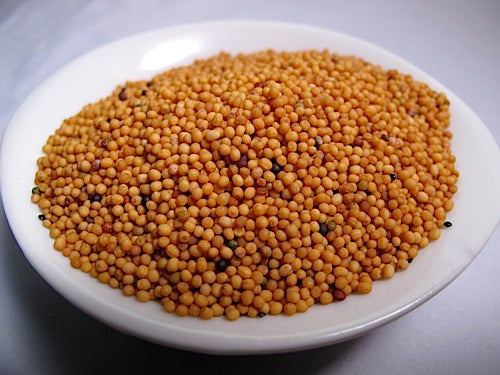
Oriental Mustard seed is one of very few non-mucilaginous mustard seeds. It is because it is not mucilaginous that it can be grown as a sprout. It can Also be grown as a Microgreen. A mucilaginous mustard seed Must be grown as a Microgreen. That's a big part of why Oriental Mustard is such a great seed - you have options =:-)
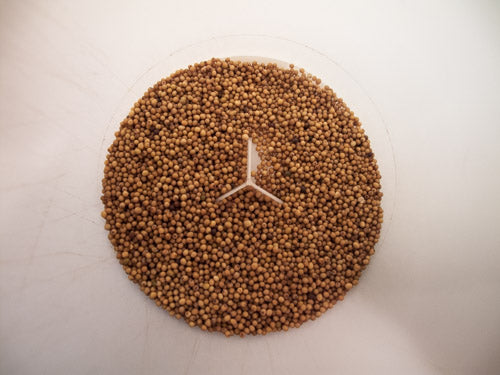
3 Tablespoons are now in one of our Easy Sprout Sprouters awaiting Soaking.
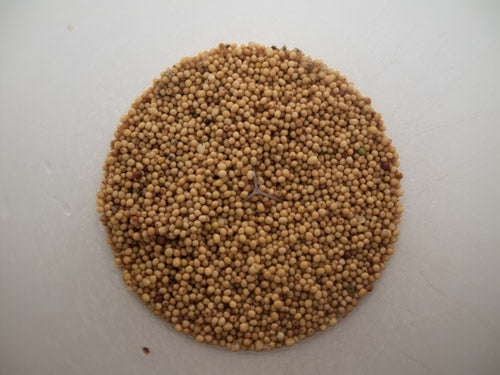
6-12 hours later (it really doesn't matter)...
Our Oriental Mustard has now Soaked up its fill of water. FYI - you are now working with living things. Once a seed has soaked up its fill of water it is alive. Having moved from its dry/dormant state you can actually eat them now and enjoy the nutritional benefits their life force offers. I suggest waiting. They are going to be even better in a few days. Now, Rinse and Drain very thoroughly.
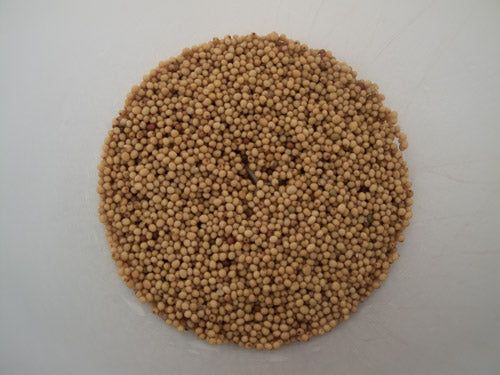
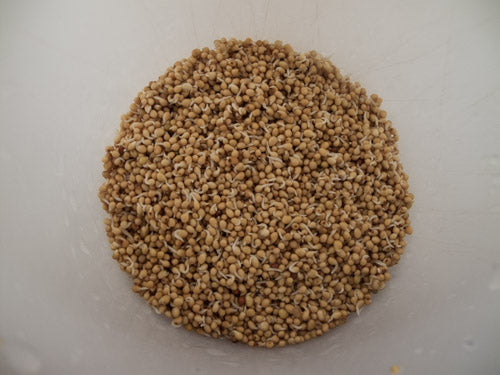
12 hours later...
By now you will be seeing plenty of germination and very likely root hairs which grow off the main (tap) root. They are microscopic roots! They are NOT mold!
They will collapse back against the tap roots after you Rinse, and will only reappear when the sprouts are at their driest - just before you Rinse again - so expect to see more in 12 hours. They are amazing. If you have a magnifying glass try to get a close-up look at them. Again, Rinse and Drain very thoroughly.
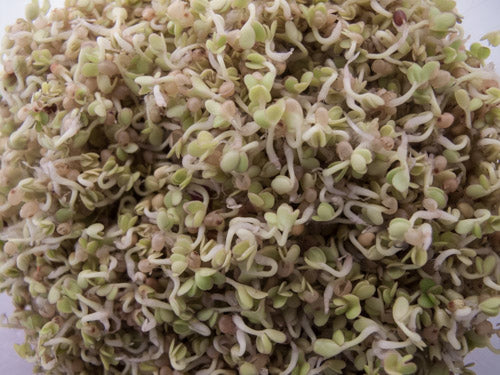
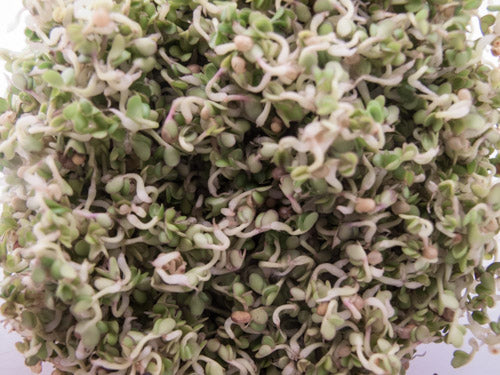
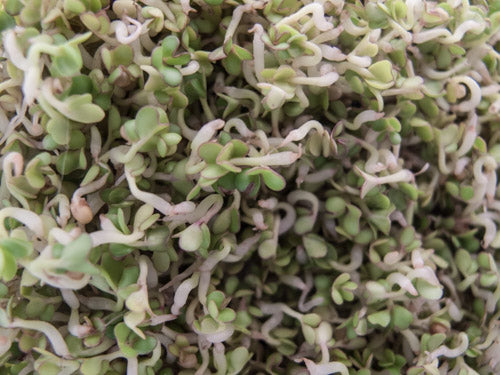
12 hours later...
At this point I like to remove some hulls. It will make it easier to Drain thoroughly. To do this I fill my sprouter with water and use a fork to reach down and loosen the sprouts so that they move freely. Hulls (the coat of the seed) will float to the top. I guide them over into a group and scoop them out with my fingers. I do this - moving the sprouts and collecting the hulls - several times, until I am satisfied that I've gotten most of them, then I Drain thoroughly.
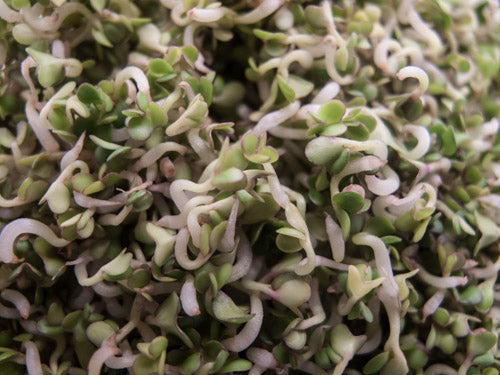
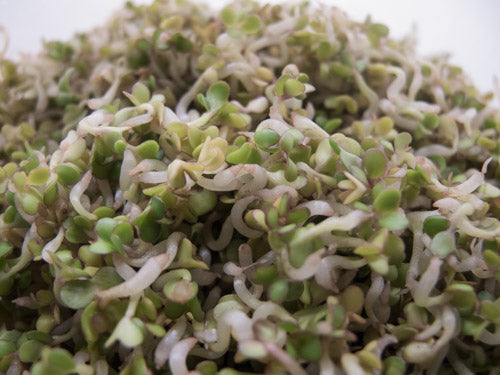
12 hours later...
Harvesting Brassicas requires one additional step; De-Hulling. I spent enough time removing hulls a day ago that de-hulling now will take little effort and time, but it is a virtual necessity if you want to store your crop for more than a few days. The hulls of Brassica sprouts are quite thick and are very moist, so removing them is key to getting shelf life from the finished crop. We have photos and a video on our De-Hulling page.
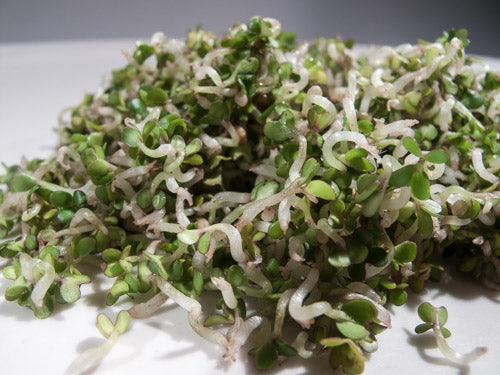
Great job sprout farmer!

Oriental Mustard seed is one of very few non-mucilaginous mustard seeds. It is because it is not mucilaginous that it can be grown as a sprout. It can Also be grown as a Microgreen. A mucilaginous mustard seed Must be grown as a Microgreen. That's a big part of why Oriental Mustard is such a great seed - you have options =:-)

3 Tablespoons are now in one of our Easy Sprout Sprouters awaiting Soaking.

6-12 hours later (it really doesn't matter)...
Our Oriental Mustard has now Soaked up its fill of water. FYI - you are now working with living things. Once a seed has soaked up its fill of water it is alive. Having moved from its dry/dormant state you can actually eat them now and enjoy the nutritional benefits their life force offers. I suggest waiting. They are going to be even better in a few days. Now, Rinse and Drain very thoroughly.


12 hours later...
By now you will be seeing plenty of germination and very likely root hairs which grow off the main (tap) root. They are microscopic roots! They are NOT mold!
They will collapse back against the tap roots after you Rinse, and will only reappear when the sprouts are at their driest - just before you Rinse again - so expect to see more in 12 hours. They are amazing. If you have a magnifying glass try to get a close-up look at them. Again, Rinse and Drain very thoroughly.



12 hours later...
At this point I like to remove some hulls. It will make it easier to Drain thoroughly. To do this I fill my sprouter with water and use a fork to reach down and loosen the sprouts so that they move freely. Hulls (the coat of the seed) will float to the top. I guide them over into a group and scoop them out with my fingers. I do this - moving the sprouts and collecting the hulls - several times, until I am satisfied that I've gotten most of them, then I Drain thoroughly.


12 hours later...
Harvesting Brassicas requires one additional step; De-Hulling. I spent enough time removing hulls a day ago that de-hulling now will take little effort and time, but it is a virtual necessity if you want to store your crop for more than a few days. The hulls of Brassica sprouts are quite thick and are very moist, so removing them is key to getting shelf life from the finished crop. We have photos and a video on our De-Hulling page.

Great job sprout farmer!
Yields approximately 3 Cups (1/2 lb.) of Sprouts
Prep 3 Tablespoons of seed* then transfer (if necessary) into a bowl or into your Sprouter. Add 2-3 times as much cool (60°-70°) water. Mix seeds up to assure even water contact for all. Note: brassicas tend to float. Try to sink those that do by knocking them down with your fingers. It isn't a big deal but it is a good habit.
Allow seeds to Soak for 4-6 hours. Empty the seeds into your sprouter (if necessary). Drain off the soak water. You may water plants or use it in stock if you like - it has nutrients in it. Rinse thoroughly with cool (60°-70°) water. Drain thoroughly! In order to grow Oriental Mustard as a Sprout you MUST Drain like a Maniac. Nothing less will work.
Set your Sprouter anywhere out of direct sunlight and at room temperature (70° is optimal) between Rinses. This is where your sprouts do their growing. We use a counter top - in the corner of our kitchen, but where the sprouter won't get knocked over by cats, dogs, kids or us. We don't mind the indirect sunlight or the 150 watts of incandescent light, because light just does not matter much. A plant can only perform photosynthesis when it has leaves. Until a plant has leaves, light has little if any effect. Sprouts also happen to like air-circulation, so don't hide your sprouts. This will be plenty of light when the sprouts are ready for it.
Rinse and Drain again every 8-12 hours for 3 days. As long as you grow you have to keep the sprouts happy!
Always be sure to Drain very thoroughly. The most common cause of inferior sprouts is inadequate drainage. Most sprouters look like they will not hold water, but even the best designed device does, so pay special attention to this step.
Note: These wonderful little brassica plants have a unique root structure. Brassicas will show microscopic roots starting around day 3. They are called root hairs and are most visible just before Rinsing when the sprouts are at their driest. When you Rinse, the root hairs will collapse back against the main root. These root hairs impress many people as mold - but they are not. Now you know!
Greening On the 4th day relocate your sprouts if necessary. If you've been keeping them away from light, move them. Avoid direct sun - it can cook your sprouts. Indirect sunlight is best but virtually any light will do. Experiment - you will be amazed at how little light sprouts require to green up. Photosynthesis is a marvel!
Continue to Rinse and Drain every 8-12 hours. As long as you grow you have to keep the sprouts happy.
Finishing Your sprouts will be done during day 5 or 6. The majority of sprouts will have open leaves which will be green if you exposed them to light.
De-Hull Before your final Rinse; remove the seed hulls. Brassica sprout hulls are quite large (relative to the seed and sprout) and they hold a lot of water (which can dramatically lessen the shelf life of your sprouts), so we remove them Thusly:
Transfer the sprouts to a big (at least 2 times the volume of your sprouter) pot or bowl, fill with cool water, loosen the sprout mass and agitate with your hand. Skim the hulls off the surface and compost them. Return the sprouts to your sprouter for their Rinse and Drain. You can also use our Dehuller (a small salad spinner with an excellent design that minimizes the sprouts that escape in the dehulling process). That's the short course - here is the full lesson. Better yet, here is a video on de-hulling.
Harvest If you Dehulled with our Dehuller, or used a salad spinner after dehulling in a bowl, you can go right to refrigeration. If not... Your sprouts are done 8-12 hours after your final Rinse. After the De-Hulling and the final Rinse we need to Drain very thoroughly and let our sprouts dry a bit. If we minimize the surface moisture of our sprouts they store much better in refrigeration, so we let them sit for 8-12 hours....
Refrigerate Transfer the sprout crop to a plastic bag or the sealed container of your choice. We have Produce Storage Bags that will extend shelf life substantially.
* If using Sproutpeople's Single Harvest Pack - use the whole bag. It will produce a crop of approximately 8 ounces.
These seeds yield approximately 5:1 - which means the sprouts will weigh 5 times as much as the seed you start with, but, they will increase even more in volume - so don't start with more than 3.5 Tablespoons per quart/litre of sprouter capacity.
Micro-Greens Note:
You can also grow Oriental Mustard as a Micro-Green as described on our Spicy Salad Greens page.
A wonderful tender sprout, this Mustard tastes like Horseradish - Mmmmm! This is Oriental Mustard - it is a yellow seed and is the only non-muciloginous Mustard we've ever seen and therefore the only (non-Asian) Mustard you can sprout in a conventional sprouter. This is one of the more difficult sprouts to grow, but the flavor is so fantastic that we consider it worth the extra work. Oriental Mustard is hard to find as very few farmers grow it. We have gone years without it more than once, so get it while you can. Our current crop is something of a miracle in fact. Early snow in Saskatchewan this past fall buried a beautiful crop of Oriental Mustard. The miracle is that there was a freak warm spell in November (amazing!) that lasted long enough (amazing!) for the seed to get harvested. Beyond that, the moisture did not damage the seed. That is truly amazing.
You can also grow Oriental Mustard as a Micro-Green.
Note: Canadian and US researchers have found that Brassicas contain antioxidants such as sulfurophane. Mustard is a Brassica.
Another wonderful Lot of our favorite Mustard. A very prolific seed this!
Seed Shelf Life: 5 years. Store in cool, dark, dry spot. Store in freezer to extend shelf life.
Recommended Sprouters for Mustard Sprouts
I like to barely sprout my mustard seeds then make mustard with them. Adds a bit of a green taste but very tasty and healthy when made with unfiltered, organic ACV!!
I like to barely sprout my mustard seeds then make mustard with them. Adds a bit of a green taste but very tasty and healthy when made with unfiltered, organic ACV!!
I accidentally tipped over my bamboo sprouting basket and dropped about a cup of these sprouted beauties on the floor. My little terrier mix named Oscar raced in and began quickly devouring them. He absolutely LOVED these sprouts!
I also REALLY like them and find that not only are they very attractive once they show leaves, but they have a nice spicy kick and would work very well with bland flavors in your meal.
I accidentally tipped over my bamboo sprouting basket and dropped about a cup of these sprouted beauties on the floor. My little terrier mix named Oscar raced in and began quickly devouring them. He absolutely LOVED these sprouts!
I also REALLY like them and find that not only are they very attractive once they show leaves, but they have a nice spicy kick and would work very well with bland flavors in your meal.

